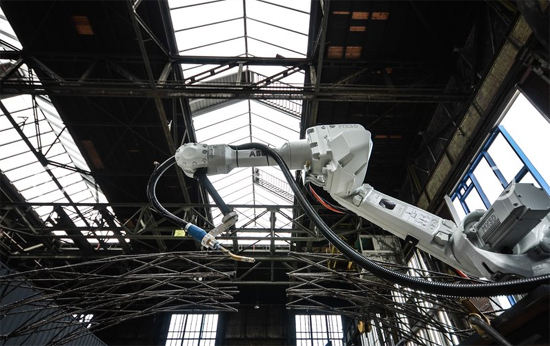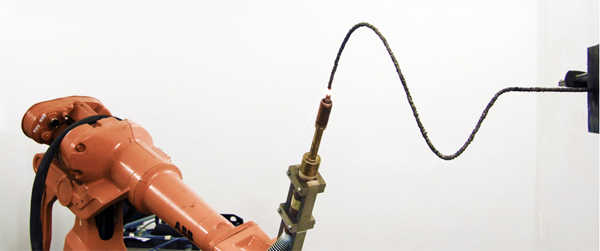World’s First 3D-Printed Bridge Paves Way to a New Era of Construction

Prototype of the 3D printed bridge under construction. Courtesy of MX3D.
Latest News
April 20, 2016
By Ronan Ye, Guest Contributor
The romantic, old-Europe charm of Amsterdam has been a treat to tourists all over the world who rush to this serene and bicycle obsessed city. Beyond the canals and 17th century architecture straight out of a fairy tale, the city is also famous for its technological research advances. The city’s historic past and love for technology is going to be manifested harmoniously in a one-of-a-kind project: the first 3D printed bridge. The first fully functional 3D-printed bridge is the brainchild of MX3D, a Dutch technology startup.
Due to the fact that Amsterdam’s streets are too narrow and crowded, the actual printing will not take place in the bridge site. Instead, it is being built inside a warehouse that is situated in the north end of the city where spectators can witness the construction on Fridays. After completion of the project by 2017, the bridge is destined to span the Oudezids Achterburgwal canal in the Amsterdam.
 Prototype of the 3D printed bridge under construction. Courtesy of MX3D.
Prototype of the 3D printed bridge under construction. Courtesy of MX3D.The Technology
The bridge is being built in collaboration with the Amsterdam City Council, MX3D and some other large companies. What’s more surprising is the fact that MX3D will construct the entire bridge with the help of autonomous robots, which can print these complex steel structures midair. These torch wielding welder robots are used to melt the layers of steel together to form one solid bridge, according to co-founder and chief technology officer of MX3D, Tim Geutjens. The bridge is the first project of this magnitude undertaken by the company. In the past, MX3D has used robots to build giant furniture pieces and free-form sculptures with the help of 3D printing technologies.
Unlike 3D printers on a desktop, MX3D’s robots resemble gigantic mechanical arms with a torch-like apparatus at the ends. These robots print objects out in the open instead of printing inside a box. With the help of their welding torches, they melt a single layer of steel, covering the layer with more melted steel coming from a length of wire that the robots keep melting.
While most 3D printers can print in only three directions i.e. forward-backward, left to right and up-down, the robots of MX3D are able to print in all directions. To print an object that protrudes from the middle of a wall, the robots simply turn their welding torches to the side. This omni-directional printing ability gives the company an upper hand while completing a project of such a large scale.
Partnership with Autodesk
California-based CAD software giant Autodesk has been working with MX3D. The company’s AutoCAD software has been helping engineers, architects and design professionals create digital models of real life objects since it was first released in 1982. The two companies have come together to explore the possibilities of developing software that can help human operators communicate with the 3D printing robots in a more efficient manner.
Autodesk is enabling MX3D to test software optimizing computer aided designs to easily model objects for the real-world construction sphere. The project is a demonstration of one way to adapt 3D printing in the physical world — taking it one step ahead of rapid prototyping. MX3D is breaking the three greatest obstacles that have preventing 3D printing technology to be adapted more into mainstream manufacturing methods: speed, size and cost.
The brief video clip below shows a snippet of Autodesk CEO Carl Bass' visit to MX3D.
Larger Structures
The 3D printing robots are able to print out objects that are significantly larger than those printed using other 3D printing techniques by moving on a track specifically designed for them. They are to print a portion of the bridge and then go along the track over new sections that require printing next.
Even though the actual cost of the project has not been announced, the authorities at MX3D say the overall cost will be less than SLM (selective laser melting) 3D printing methods. Geurtjens says that SLM is a viable method for parts requiring high accuracy, but it is not suitable or cost effective for creating mega-structures like entire bridges.
 MX3D can build lines in midair from molten metal. Courtesy of Joris Laarman Lab.
MX3D can build lines in midair from molten metal. Courtesy of Joris Laarman Lab.Compared to traditional steel welding, the process of 3D printing with robots is a much faster process. The robots can build the bridge at least a thousand times faster than traditional metal welding techniques.
The Future is Here
Though the 3D printing robots are not going to take over the metal construction industry anytime soon, enthusiasts of the field sure are optimistic. There are many limitations of the method, yet the robots can successfully do the more dangerous parts of the job that are unsafe for humans. Perhaps we can expect to see these torch-bearing robotic arms constructing bridges for heavy vehicles. They can also be useful for repairing broken satellites in the outer space and repair of oil rigs offshore.
The only place to see metal working robots in action right now is the visitor’s center of MX3D located in Neveritaweg 15, Amsterdam. It is open for visitors at 4 p.m. every Friday.
Ronan Ye is the founder and managing director of 3E-RP, a provider of rapid prototyping services in China. The opinions and views expressed in this guest blog post are the author’s own.
Subscribe to our FREE magazine, FREE email newsletters or both!
Latest News






